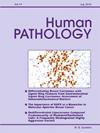Optical genome mapping reveals diverse mechanisms of cyclin activation in mantle cell lymphomas lacking IGH::CCND1
IF 2.6
2区 医学
Q2 PATHOLOGY
引用次数: 0
Abstract
The t(11;14)(q13; q32)/IGH::CCND1 is a genetic hallmark of mantle cell lymphoma (MCL), reported to be present in about 95% of cases. In this study, we performed optical genome mapping (OGM) on 91 patients with MCL, in conjunction with next-generation sequencing (NGS), conventional chromosomal analysis and fluorescence in situ hybridization (FISH). The t(11;14)/IGH::CCND1 was detected in 82 cases, whereas 9 (10%) cases lacked this abnormality. OGM and NGS identified alternative CCND1 abnormalities in 7 cases: IGK::CCND1 (n = 3), IGL::CCND1 (n = 1), an insertion adjacent to the 5′ region of CCND1 (n = 1); a deletion at the 5′ region of CCND1 (n = 1), and a mutation in the 3ʹ untranslated region of CCND1 (n = 1). OGM detected CCND2 rearrangement with IGK or IGL in the other 2 cases. All 7 cases exhibiting CCND1 aberrations expressed cyclin D1, although some lacked SOX11 or CD5 expression. The two cases with CCND2 rearrangement were SOX11-positive. Six cases showed highly complex genome detected by OGM and the affected patients were refractory to chemotherapy and/or had poorer survival. In conclusion, approximately 10% of MCL cases lack the classic t(11;14)/IGH::CCND1. OGM is valuable in identifying variant CCND1 and CCND2 rearrangements, and the presence of high genome complexity may correlate with treatment resistance and poor outcomes.
光学基因组图谱揭示了缺乏IGH::CCND1的套细胞淋巴瘤中细胞周期蛋白激活的多种机制
t(11、14)(问题;q32)/IGH::CCND1是套细胞淋巴瘤(MCL)的遗传标志,据报道约95%的病例中存在CCND1。在这项研究中,我们对91名MCL患者进行了光学基因组定位(OGM),结合下一代测序(NGS)、常规染色体分析和荧光原位杂交(FISH)。82例检测到t(11;14)/IGH::CCND1,而9例(10%)未检测到该异常。OGM和NGS发现7例CCND1异常:IGK::CCND1 (n = 3), IGL::CCND1 (n = 1),靠近CCND1 5 '区域的插入(n = 1);CCND1的5′区缺失(n = 1), CCND1的3′非翻译区突变(n = 1)。OGM检测到另外2例CCND2与IGK或IGL重排。CCND1畸变的7例患者均表达cyclin D1,但部分患者缺乏SOX11或CD5表达。2例CCND2重排为sox11阳性。6例OGM检测到的基因组高度复杂,患者化疗难治和/或生存率较低。总之,大约10%的MCL病例缺乏典型的t(11;14)/IGH::CCND1。OGM在鉴定变异CCND1和CCND2重排方面很有价值,高基因组复杂性的存在可能与治疗耐药性和不良预后相关。
本文章由计算机程序翻译,如有差异,请以英文原文为准。
求助全文
约1分钟内获得全文
求助全文
来源期刊

Human pathology
医学-病理学
CiteScore
5.30
自引率
6.10%
发文量
206
审稿时长
21 days
期刊介绍:
Human Pathology is designed to bring information of clinicopathologic significance to human disease to the laboratory and clinical physician. It presents information drawn from morphologic and clinical laboratory studies with direct relevance to the understanding of human diseases. Papers published concern morphologic and clinicopathologic observations, reviews of diseases, analyses of problems in pathology, significant collections of case material and advances in concepts or techniques of value in the analysis and diagnosis of disease. Theoretical and experimental pathology and molecular biology pertinent to human disease are included. This critical journal is well illustrated with exceptional reproductions of photomicrographs and microscopic anatomy.
 求助内容:
求助内容: 应助结果提醒方式:
应助结果提醒方式:


